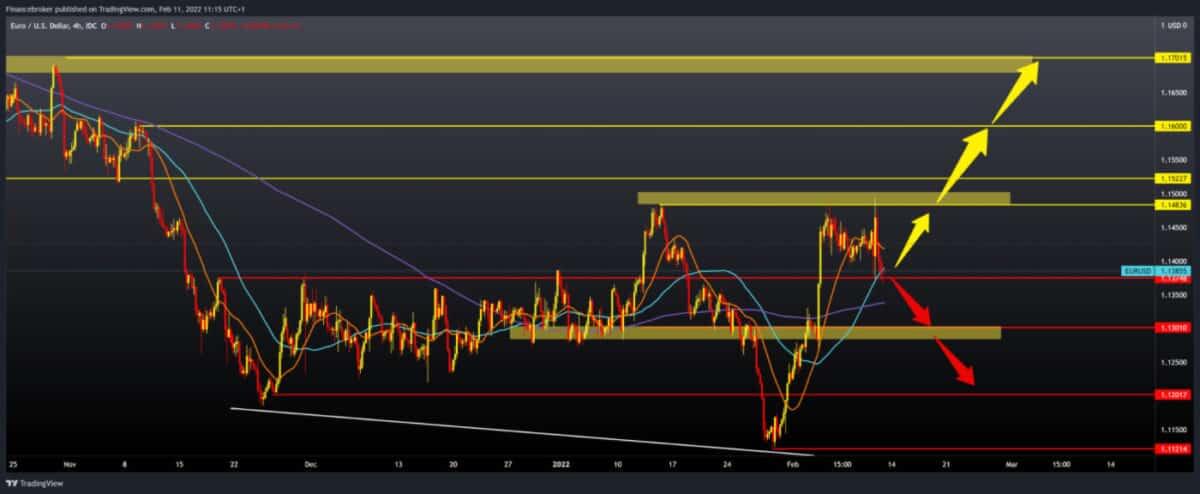EURUSD and GBPUSD continue consolidation
EURUSD chart analysis
During the Asian session, the euro weakened against the dollar after large fluctuations yesterday. Price inflation in the US was 7.5% year-on-year in January, well above expectations of + 7.2%, according to data released yesterday afternoon. The data sent a signal to investors about a possible rapid increase in the Fed’s reference interest rate, which raised interest in holding dollar-denominated debt securities. On the other hand, there is no agreement within the ECB on the need to increase the reference rate, and this morning it was announced that inflation was at the level of expectations. Currently, the euro is exchanged for 1.13880 dollars, which is a weakening of the common European currency by 0.32% since the beginning of trading tonight.
Bullish scenario:
- We need a new positive consolidation that will separate us from the current support at 1.13750.
- After that, we can expect re-testing of the previous resistance zone 1.14850-1.15250.
- If the bullish momentum continues, we move on to the next potential resistance zone at 1.16000, and the break above us can lead to 1.17000.
Bearish scenario:
- We need to continue the current negative consolidation and raise the price to 1.13500.
- The MA200 moving average can provide additional potential support for this level.
- In the further withdrawal of EURUSD, we descend further to 1.13000, and if the bearish pressure continues, we fall further to 1.12000 of potential support.
- The maximum drop in EURUSD on this time frame is up to 1.11200, the January low.
GBPUSD chart analysis
Pair GBPUSD during this week is consolidating around the MA200 moving average in a slight upward trend. The pair did not form a new lower low, but yesterday broke the previous high to 1.36280 and formed a new higher high at 1.36440. Due to the high volatility in the market, we immediately had a withdrawal to the support zone of around 1,35500.
Bullish scenario:
- We need continued positive consolidation and a new break above 1.36000.
- We have support in all three moving averages, and based on them, we can expect a further recovery of the pound against the dollar.
- Our next target is 1.37000, and higher resistance awaits at the previous high at 1.37500.
Bearish scenario:
- We need a negative consolidation and withdrawal of GBPUSD below moving averages and 1.35000.
- After that, we can expect higher bearish pressure and potential withdrawal to the first support at 1.34500.
- A break below 1.34000 would open up space for us on the chart to 1.32000, support from December.
Market overview
European stock indices fell on Friday, and the ten-year yield in the U.S. remained close to 2 percent after high inflation data in the U.S., which led investors to expect stricter monetary policy from the Federal Reserve.
U.S. consumer prices showed the strongest annual rise in 40 years, data released yesterday showed. The news has fueled speculation that the Fed will increase rates by 50 basis points in March instead of 25, as previously expected. This has hurt stock markets as expectations of tighter monetary policy generally reduce investors’ appetite to buy assets due to changes in risk. Shares on Wall Street fell after the data, and the weakness continued throughout the Asian session.
“Real inflation is out of control,” said Matteo Cominetta, a senior economist at the Barings Investment Institute. “We have all these factors that drive costs on the one hand, and then you have growing demand that affects limited supply on the other hand. It is very difficult to see how inflation could slow down soon in the United States. “The yield of the 10-year U.S. Treasury reached 2% for the first time since August 2019.
European Central Bank President Christine Lagarde said that the current increase in rates would only harm the economy. These comments were the opposite of the tone at last week’s meeting of the ECB when Lagarde surprised the markets by opening the door to the first increase in the ECB’s interest rate in more than a decade in order to curb record-high inflation.




